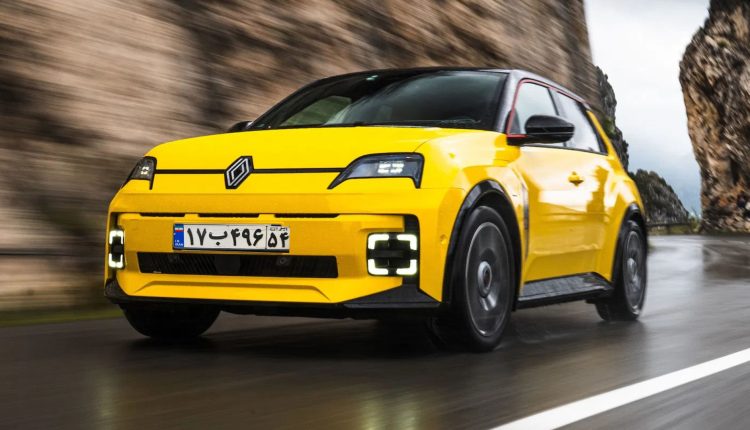Car Import Rules for Iranians Living Abroad in 2025: Full Guide and Tariff Breakdown
Car import rules for Iranians living abroad in 2025: full guide and tariff breakdown
Both the European and Asian markets are now hotbeds of innovation in terms of EVs, with the Renault 5-Etech (pictured above), (remember “PK”), being voted the top car in 2024 in Europe. So why not bring one over to Tehran! We just love the yellow.
Thanks to low import tariffs, cutting-edge technology, and a growing global shift towards cleaner transport, choosing an EV from these regions offers both financial savings and environmental benefits — making it the perfect time for Iranian expatriates to go electric. Ironically, with vehicle-to-load ability, an EV could also power your house during the successive power cuts across the city (swings and roundabouts).
Overview of the 2025 plan
The Pezeshkian government’s 2025 car import scheme seeks to manage foreign currency while meeting pent-up market demand for imported cars. Iranians with valid residence status abroad may import qualifying vehicles under a defined process and timetable.
Eligibility criteria
- Minimum age: 18.
- Hold a valid residence permit abroad (temporary or permanent).
- Residence card issued before 21 Khordad 1404 (10 June 2025).
- Spend at least 18 days during 1404 (2025) in the country of residence.
Required documents
- Valid passport
- Residence card
- National ID and birth certificate
- Accurate contact information
- Proof of car purchase and/or proof of foreign currency origin
Key dates and currency rules
Cut-off date: 21 Khordad 1404 (10 June 2025)
- Before 10 June 2025: No restriction on engine capacity and no limitation on currency origin.
- On/after 10 June 2025: Imports permitted only using funds from the importer’s own foreign bank account.

Vehicle scope and restrictions
- Permitted: New or used cars, model years 2020–2025.
- Used cars: maximum 100,000 km mileage.
- Prohibited: Diesel cars, right-hand drive cars, and American-made cars.
- Additional limits apply to super-luxury vehicles.
- Engines above 2,500 cc may be imported only before 10 June 2025 and face heavy tariffs.
Tariff structure (2025)
| Vehicle type | Tariff rate |
|---|---|
| Electric | 4% |
| Hybrid | 15% |
| Petrol up to 1,500 cc | 20% |
| Petrol 1,500–2,000 cc | 40% |
| Petrol 2,000–2,500 cc | 155% |
| Petrol 2,500–3,000 cc | 180% |
| Petrol over 3,000 cc | 190% |
Step-by-step process
- Register in the so-called (integrated management system for expatriates) Mikhak system (if you don’t read Persian, you can use this link and maybe your friend or spouse to help you.)
- Complete submission in the Comprehensive Trade System (again, it’s in Persian, so…).
After these two stages, customs clearance can begin. There is no limitation on transferring ownership; once registered and plated, the importer may sell or transfer the vehicle.
Deadline
The scheme runs until 29 Esfand 1404 (20 March 2026), so hurry up!
Why it matters
The framework opens a regulated pathway for expatriates to bring modern vehicles into Iran. While large-engine petrol cars face very high duties, the low tariff for electric and the moderate rate for hybrid vehicles make cleaner options more attractive.
Why importing electric cars from Europe and Asia makes sense
Importing electric vehicles (EVs) from Europe and Asia offers the best value for Iranian expatriates seeking efficiency, quality, and long-term savings. European manufacturers such as Volkswagen, Renault, and BMW have established strong reputations for reliability and safety, while Asian brands like Hyundai, Kia, and BYD dominate the global market with affordable, high-range EVs. These regions lead the world in electric mobility innovation, supported by mature supply chains, advanced battery technology, and competitive pricing that significantly reduce total ownership costs.
With Iran’s 2025 tariff on electric cars set at just 4%, importing from these regions presents an exceptional opportunity to save money and avoid the heavy duties imposed on petrol engines. EVs also require less maintenance, benefit from lower energy costs, and align with global environmental targets that are increasingly shaping consumer and government policy. For Iranians abroad looking to invest in a future-proof vehicle, choosing an electric model from Europe or Asia combines practicality, sustainability, and economic advantage in a single, forward-looking decision.
Sources: Fararu; Khodro Bank. Published: November 2025.


